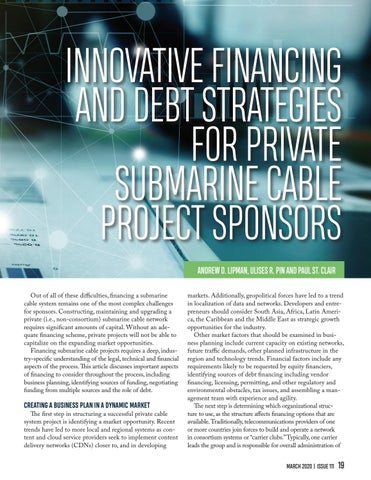INNOVATIVE FINANCING AND DEBT STRATEGIES FOR PRIVATE SUBMARINE CABLE PROJECT SPONSORS ANDREW D. LIPMAN, ULISES R. PIN AND PAUL ST. CLAIR Out of all of these difficulties, financing a submarine cable system remains one of the most complex challenges for sponsors. Constructing, maintaining and upgrading a private (i.e., non-consortium) submarine cable network requires significant amounts of capital. Without an adequate financing scheme, private projects will not be able to capitalize on the expanding market opportunities. Financing submarine cable projects requires a deep, industry-specific understanding of the legal, technical and financial aspects of the process. This article discusses important aspects of financing to consider throughout the process, including business planning, identifying sources of funding, negotiating funding from multiple sources and the role of debt.
CREATING A BUSINESS PLAN IN A DYNAMIC MARKET
The first step in structuring a successful private cable system project is identifying a market opportunity. Recent trends have led to more local and regional systems as content and cloud service providers seek to implement content delivery networks (CDNs) closer to, and in developing
markets. Additionally, geopolitical forces have led to a trend in localization of data and networks. Developers and entrepreneurs should consider South Asia, Africa, Latin America, the Caribbean and the Middle East as strategic growth opportunities for the industry. Other market factors that should be examined in business planning include current capacity on existing networks, future traffic demands, other planned infrastructure in the region and technology trends. Financial factors include any requirements likely to be requested by equity financiers, identifying sources of debt financing including vendor financing, licensing, permitting, and other regulatory and environmental obstacles, tax issues, and assembling a management team with experience and agility. The next step is determining which organizational structure to use, as the structure affects financing options that are available. Traditionally, telecommunications providers of one or more countries join forces to build and operate a network in consortium systems or “carrier clubs.� Typically, one carrier leads the group and is responsible for overall administration of MARCH 2020 | ISSUE 111
19
